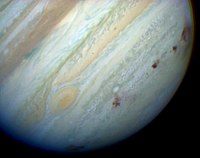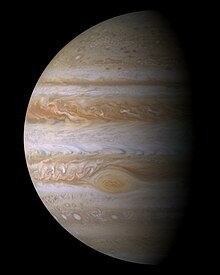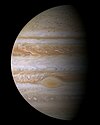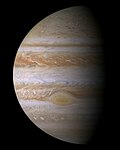Exploration of Jupiter
The Exploration of Jupiter began with first spacecraft mission to visit Jupiter in 1973, and as of 2008, another seven have explored the Jovian system. All of these were automated spacecraft missions by NASA, most of which have been "flybys" that take detailed observations without the probe landing or entering orbit. These include two from the Pioneer program, the two Voyagers, and the Ulysses, Cassini, and New Horizons probes. Galileo spacecraft is the only one to have orbited the planet, and the only one to have entered its atmosphere. These probes make Jupiter the most visited of the outer planets of the Solar System. Plans for more missions to visit the Jovian system are under development.
Technical requirements
Flights to other planets within the Solar System are accomplished at a high cost in energy. In order for a spacecraft to reach the orbit of Jupiter from the Earth's orbit, it requires almost the same amount of energy as it does to lift it from the surface of Earth and put it into a low Earth orbit. This necessary energy is described in astrodynamics by the net change in velocity of the spacecraft, or delta-V. The energy needed to reach Jupiter from an Earth orbit requires a delta-V of 9.2 km/s,[1] which is comparable to the 9.7 km/s delta-V needed to reach a low Earth orbit from ground.[2] However, gravity assists through planetary flybys can sometimes be used to reduce the energy required at launch to reach Jupiter, albeit at the cost of a significantly longer flight duration.[1]
A major problem in sending space probes to Jupiter is that the planet appears to have no real solid surface for landing, and that there is a smooth transition between the atmosphere of Jupiter and the planet's fluid interior. Since it only has a small rocky core, the probes that land fall deep into the planet and are eventually crushed by the immense pressures within Jupiter before reaching any solid point, thus making impossible a landing mission to Jupiter.[3] Another major issue is the amount of radiation to which a space probe is subjected, due to the harsh charged-particle environment around Jupiter. For example, the Galileo spacecraft, over the years it has orbited the planet, has far exceeded the radiation dose for which it was designed; as a result there have been a number of system failures attributable to radiation effects.[4]
Flyby missions
Pioneer program (1973 and 1974)

Pioneer 10 flew past Jupiter in December 1973, the first spacecraft to ever explore Jupiter, followed by Pioneer 11 thirteen months later. Pioneer 10 obtained the first-ever close up images of Jupiter (on December 3) and its Galilean moons; it studied its atmosphere, detected its magnetic field, observed its radiation belts and determined that Jupiter is mainly liquid. Pioneer 11 made its closest approach on December 4, 1974 — within some 34,000 km of Jupiter's cloud tops — and obtained dramatic images of the Great Red Spot. It made the first observation of Jupiter's immense polar regions, and determined the mass of Jupiter's moon Callisto.[5]
Voyager program (1979)
Voyager 1 began photographing Jupiter in January 1979 and made its closest approach on March 5, 1979, at a distance of 349,000 km from Jupiter's center. Due to the greater resolution allowed by this close approach, most observations of the moons, rings, magnetic fields, and radiation environment of the Jupiter system were made in the 48-hour period bracketing this approach. It finished photographing the planet in April. It was soon followed by Voyager 2, which made its closest approach on July 9, 1979, 570,000 km away from the planet's cloud tops.[6]

The Voyager missions vastly improved the understanding of the Galilean moons as well as discovering Jupiter's rings. They also took the first close up images of the planet's atmosphere, revealing that the Great Red Spot is a complex storm moving in a counterclockwise direction. An array of other smaller storms and eddies were found throughout the banded clouds. Two new, small satellites, Adrastea and Metis, were discovered orbiting just outside the ring, making them the first of Jupiter's moons to be identified by a spacecraft. A third new satellite, Thebe, was discovered between the orbits of Amalthea and Io.[6]
Discovery of volcanic activity on the moon Io was the greatest unexpected discovery regarding Jupiter, since it was the first time an active volcano has been observed on another celestial body. Together, the Voyagers recorded the eruption of nine volcanoes on Io, and there is evidence that other eruptions occurred between the Voyager encounters.
Europa displayed a large number of intersecting linear features in the low-resolution photos from Voyager 1. At first, scientists believed the features might be deep cracks, caused by crustal rifting or tectonic processes. However, the high-resolution photos from Voyager 2, taken closer to Jupiter, left scientists puzzled as the features in these photos were so lacking in topographic relief that, as one scientist described them, they "might have been painted on with a felt marker". Europa is internally active due to tidal heating at a level about one-tenth that of Io, and as a result, the moon is thought to have a thin crust less than 30 kilometers (18 miles) thick of water ice, possibly floating on a 50-kilometer-deep (30 mile) ocean.[6]
Ulysses (1992)
On February 8, 1992, the Ulysses solar probe flew past the north pole of Jupiter at a distance of 409,000 km (6.3 Jovian radii). This swing-by maneuver was required for Ulysses to attain a very high-inclination orbit around the Sun, increasing its inclination of the ecliptic to 80.2 degrees. The giant planet's gravity bent the spacecraft's flight path downward and away from the ecliptic plane. This put it into a final orbit around the Sun that took it past the Sun's north and south poles. The size and shape of the orbit were adjusted to a much smaller degree so that the aphelion remained at approximately 5 AU, Jupiter's distance from the sun, and perihelion was somewhat greater than 1 AU, the Earth's distance from the sun. During this pass, the probe made measurements of Jupiter's magnetosphere. However, since there are no cameras on board the probe, no images were taken. In February 2004, the probe came again to the vicinity of Jupiter. This time the distance from the planet was much greater—about 240 million km—but it made further observations of Jupiter from that distance.[7][8]
Cassini (2000)

In 2000, the Cassini probe, en route to Saturn, flew by Jupiter and provided some of the highest-resolution images ever made of the planet. It made its closest approach to Jupiter on December 30, 2000, and made many scientific measurements. About 26,000 images of Jupiter were taken during the months-long flyby. It produced the most detailed global color portrait of Jupiter yet, in which the smallest visible features are approximately 60 km (40 miles) across.[9]
A major finding of the flyby, announced on March 6, 2003, was of Jupiter's atmospheric circulation. Dark "belts" alternate with light "zones" in the atmosphere, and scientists had long considered the zones, with their pale clouds, to be areas of upwelling air, partly because many clouds on Earth form where air is rising. But analysis of Cassini imagery showed that individual storm cells of upwelling bright-white clouds, too small to see from Earth, pop up almost without exception in the dark belts. Anthony Del Genio of NASA's Goddard Institute for Space Studies said that "the belts must be the areas of net-rising atmospheric motion on Jupiter, [so] the net motion in the zones has to be sinking".[10]
Other atmospheric observations included a swirling dark oval of high atmospheric-haze, about the size of the Great Red Spot, near Jupiter's north pole. Infrared imagery revealed aspects of circulation near the poles, with bands of globe-encircling winds, with adjacent bands moving in opposite directions. The same announcement also discussed the nature of Jupiter's rings. Light scattering by particles in the rings showed the particles were irregularly shaped (rather than spherical) and likely originated as ejecta from micrometeorite impacts on Jupiter's moons, probably on Metis and Adrastea. On December 19, 2000, the Cassini spacecraft captured a very low resolution image of the moon Himalia, but it was too distant to show any surface details.[11]
New Horizons (2007)

The New Horizons probe, en route to Pluto, flew by Jupiter for a gravity assist and was the first probe launched directly towards Jupiter since the Ulysses in 1990. Its Long Range Reconnaissance Imager (LORRI) took its first photographs of Jupiter on September 4, 2006.[12] The spacecraft began further study of the Jovian system in December 2006, and made its closest approach on February 28, 2007.[13]
While at Jupiter, New Horizons' instruments made refined measurements of the orbits of Jupiter's inner moons, particularly Amalthea. The probe's cameras measured volcanoes on Io and studied all four Galilean moons in detail, as well as made long distance studies of the outer moons Himalia and Elara.[14] The craft also studied Jupiter's Little Red Spot and the planet's magnetosphere and tenuous ring system.[15]
Collision of comet Shoemaker-Levy

In July 1992 the orbit of Comet Shoemaker-Levy 9 passed within Jupiter's Roche limit, and Jupiter's tidal forces acted to pull the comet apart. SL9 was later observed as a series of fragments ranging up to 2 kilometres in diameter. These fragments collided with Jupiter's southern hemisphere between July 16 and July 22, 1994, at a speed of approximately 60 kilometres per second. This was the first direct observation of an extraterrestrial collision of solar system objects.[16] Although not a probe from Earth, the impact did provide data on the composition of Jupiter's atmosphere and highlighted the planet's role in reducing space debris in the inner solar system.[17] Due to Jupiter's large mass and location near the inner solar system, the planet receives the most frequent comet impacts of all the solar system's planets.[18]
Observers had hoped that the impacts would give them a first glimpse of Jupiter beneath the cloud tops, as lower material was exposed by the comet fragments punching through the upper atmosphere. Spectroscopic observations showed the presence of diatomic sulfur (S2) and carbon disulfide (CS2), the first detection of either in Jupiter, and only the second detection of S2 in any astronomical object, as well as ammonia and hydrogen sulfide.[19] The prominent scars from the impacts were more easily visible than the Great Red Spot and persisted for many months.[20]
Galileo mission (1995–2003)

So far, the only spacecraft to orbit Jupiter is the Galileo orbiter, which went into orbit around Jupiter on December 7, 1995. It orbited the planet for over seven years, making 35 orbits before it was destroyed during a controlled impact with Jupiter on September 21, 2003. During this period it gathered a large amount of information about the Jovian system, although the amount of information was not as great as intended because the deployment of its high-gain radio transmitting antenna failed. The major events during the eight-year study included multiple flybys of all of the Galilean moons, including Amalthea (the first probe to do so). It also witnessed the impact of Comet Shoemaker-Levy 9 as it approached Jupiter in 1994 and the sending of an atmospheric probe into the Jovian atmosphere in December 1995.[21]
An atmospheric probe was released from the spacecraft in July, 1995, entering the planet's atmosphere on December 7, 1995. After a high-g descent into the Jovian atmosphere, the probe discarded the remains of its heat shield, and it parachuted through 150 km of the atmosphere, collecting data for 57.6 minutes, before being crushed by the pressure and temperature to which it was subjected (about 22 times Earth normal, at a temperature of 153 oC).[22] It would have melted thereafter, and possibly vaporized. The Galileo orbiter itself experienced a more rapid version of the same fate when it was deliberately steered into the planet on September 21, 2003 at a speed of over 50 km/s, in order to avoid any possibility of it crashing into and contaminating Europa.[21]
Major scientific results of the Galileo mission include:[21]
- the first observation of ammonia clouds in another planet's atmosphere—the atmosphere creates ammonia ice particles from material coming up from lower depths;
- confirmation of extensive volcanic activity on Io—which is 100 times greater than that found on Earth; the heat and frequency of eruptions are reminiscent of early Earth;
- observation of complex plasma interactions in Io's atmosphere which create immense electrical currents that couple to Jupiter's atmosphere;
- providing evidence for supporting the theory that liquid oceans exist under Europa's icy surface;
- first detection of a substantial magnetic field around a satellite (Ganymede);
- magnetic data evidence suggesting that Europa, Ganymede and Callisto have a liquid-saltwater layer under the visible surface;
- evidence for a thin atmospheric layer on Europa, Ganymede, and Callisto known as a 'surface-bound exosphere';
- understanding of the formation of the rings of Jupiter (by dust kicked up as interplanetary meteoroids which smash into the planet's four small inner moons) and observation of two outer rings and the possibility of a separate ring along Amalthea's orbit;
- identification of the global structure and dynamics of a giant planet's magnetosphere.
Future probes
NASA is planning a mission to study Jupiter in detail from a polar orbit. Named Juno, the spacecraft is planned to launch in August 2011. The spacecraft will be placed in a polar orbit to study the planet's composition, gravity field, magnetic field, and polar magnetosphere. Juno will also search for clues about how Jupiter formed, including whether the planet has a rocky core, the amount of water present within the deep atmosphere, and how the mass is distributed within the planet. Juno will also study Jupiter's deep winds, which can reach speeds of 600 km/h.[23]
Because of the possibility of a liquid ocean on Jupiter's moon Europa, there has been great interest in studying the icy moons in detail. A mission proposed by NASA was dedicated to study them. The JIMO (Jupiter Icy Moons Orbiter) was expected to be launched sometime after 2017. However, the mission was deemed too ambitious and its funding was canceled.[24]
In October 2007, the European Space Agency announced candidate projects for Cosmic Vision 2015-2025, blueprint of the future scientific program, which includes the Laplace Jupiter probe. This mission is aimed at studying the Jovian System, including Jupiter and its moons, and would include the gathering of data in an attempt to answer questions on the habitability of Europa, as well as questions about the Jovian system as to the formation of the Jovian satellites and the workings of the overall Jovian system. The mission would deploy three orbiting platforms to perform coordinated observations of Europa, the Jovian satellites, Jupiter’s magnetosphere and its atmosphere and interior.[25] If approved, the mission would be implemented in collaboration with the Japanese Aerospace Exploration Agency and NASA.[26]
References
- ^ a b Wong, Al (May 28, 1998). "Galileo FAQ - Navigation". NASA. Retrieved 2006-11-28.
- ^ Hirata, Chris. "Delta-V in the Solar System". California Institute of Technology. Archived from the original on 2007-07-01. Retrieved 2006-11-28.
- ^ Guillot, Tristan (1999). "A comparison of the interiors of Jupiter and Saturn". Planetary and Space Sciences. 47: 1183–1200. doi:10.1016/S0032-0633(99)00043-4.
- ^ Fieseler, P.D. (2002). "The radiation effects on galileo spacecraft systems at jupiter". IEEE Transactions on Nuclear Science. 49: 2739. doi:10.1109/TNS.2002.805386.
- ^ Lasher, Lawrence (August 1, 2006). "Pioneer Project Home Page". NASA Space Projects Division. Retrieved 2006-11-28.[dead link]
- ^ a b c "Jupiter". NASA Jet Propulsion Laboratory. January 14, 2003. Retrieved 2006-11-28.
- ^ K. Chan, E. S. Paredes, M. S. Ryne (2004). "Ulysses Attitude and Orbit Operations: 13+ Years of International Cooperation" (PDF). American Institute of Aeronautics and Astronautics. Retrieved 2006-11-28.
{{cite web}}: CS1 maint: multiple names: authors list (link) - ^ "Ulysses - Science - Jupiter Distant Encounter Selected References". NNASA. Retrieved 2008-10-21.
- ^ Hansen C. J., Bolton S. J., Matson D. L., Spilker L. J., Lebreton J. P. (2004). "The Cassini–Huygens flyby of Jupiter". ICARUS. 172: 1–8. doi:10.1016/j.icarus.2004.06.018.
{{cite journal}}: CS1 maint: multiple names: authors list (link) - ^ "Cassini-Huygens: News-Press Releases-2003". NASA. Retrieved 2008-10-21.
- ^ C. J. Hansen, S. J. Bolton, D. L. Matson, L. J. Spilker, J.-P. Lebreton (2004). "The Cassini-Huygens flyby of Jupiter". Icarus. 172 (1): 1–8. doi:10.1016/j.icarus.2004.06.018.
{{cite journal}}: CS1 maint: multiple names: authors list (link) - ^ Alexander, Amir (September 27, 2006). "New Horizons Snaps First Picture of Jupiter". The Planetary Society. Retrieved 2006-12-19.
- ^ "New Horizons Web Site". Johns Hopkins University. Retrieved 2008-11-02.
- ^ "New Horizons targets Jupiter kick". BBC News Online. 2007-01-19. Retrieved 2007-01-20.
- ^ "Fantastic Flyby", NASA, May 1, 2007
- ^ "Comet Shoemaker-Levy 9 Collision with Jupiter". National Space Science Date Center, NASA. 2005. Retrieved 2008-08-26.
{{cite web}}: Unknown parameter|month=ignored (help) - ^ Baalke, Ron. "Comet Shoemaker-Levy Collision with Jupiter". NASA. Retrieved 2007-01-02.
- ^ T. Nakamura, H. Kurahashi (1998). "Collisional Probability of Periodic Comets with the Terrestrial Planets: An Invalid Case of Analytic Formulation". Astronomical Journal. 115 (2): 848–854. doi:10.1086/300206.
- ^ Noll, K.S. (1995). "HST Spectroscopic Observations of Jupiter Following the Impact of Comet Shoemaker-Levy 9". Science. 267 (5202): 1307–1313. doi:10.1126/science.7871428. PMID 7871428. Retrieved 2008-08-24.
{{cite journal}}: Unknown parameter|coauthors=ignored (|author=suggested) (help); Unknown parameter|month=ignored (help) - ^ McGrath, M.A. (1996). "Long-term Chemical Evolution of the Jupiter Stratosphere Following the SL9 Impacts". Bulletin of the American Astronomical Society. 28: 1149. Retrieved 2008-08-24.
{{cite journal}}: Unknown parameter|coauthors=ignored (|author=suggested) (help); Unknown parameter|month=ignored (help) - ^ a b c McConnell, Shannon (April 14, 2003). "Galileo: Journey to Jupiter". NASA Jet Propulsion Laboratory. Retrieved 2006-11-28.
- ^ "Galileo Mission to Jupiter" (PDF). NASA. Retrieved 2008-11-01.
{{cite web}}: Text "accessdate-2008-11-01" ignored (help) - ^ "Juno - NASA's Second New Frontiers Mission to Jupiter". Retrieved 2007-10-24.
- ^ Berger, Brian (7 February 2005). "NASA 2006 Budget Presented: Hubble, Nuclear Initiative Suffer". Space.com. Retrieved 2007-06-06.
- ^ "LAPLACE — A mission to Europa and the Jupiter System for ESA's Cosmic Vision Programme" (PDF). Centre d’Etude Spatiale des Rayonnements. Retrieved 2008-11-01.
- ^ "Cosmic Vision 2015-2025: and the candidate missions are..." European Space Agency. Retrieved 2008-11-03.


